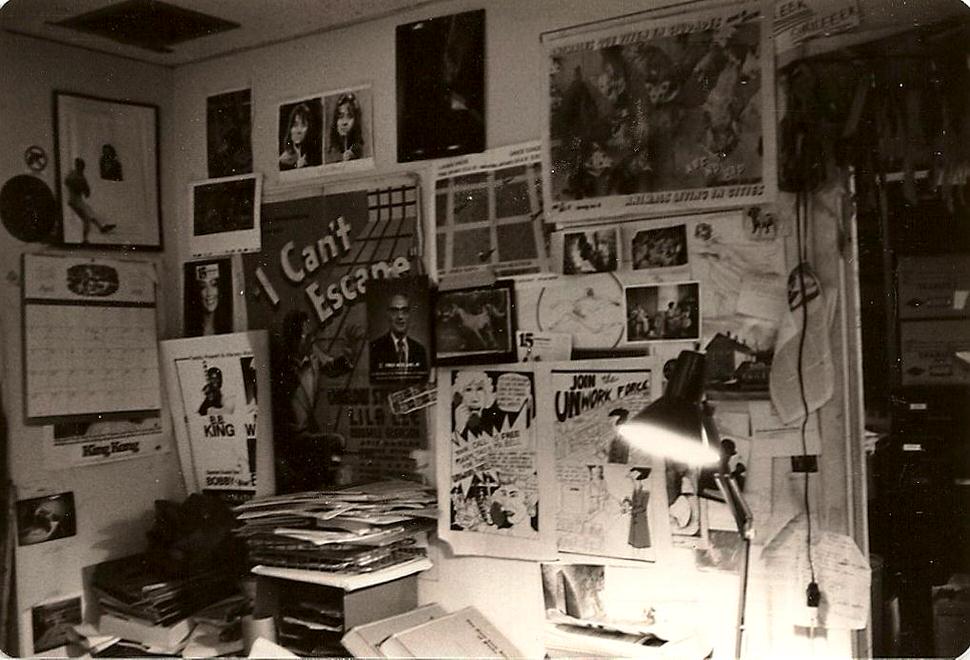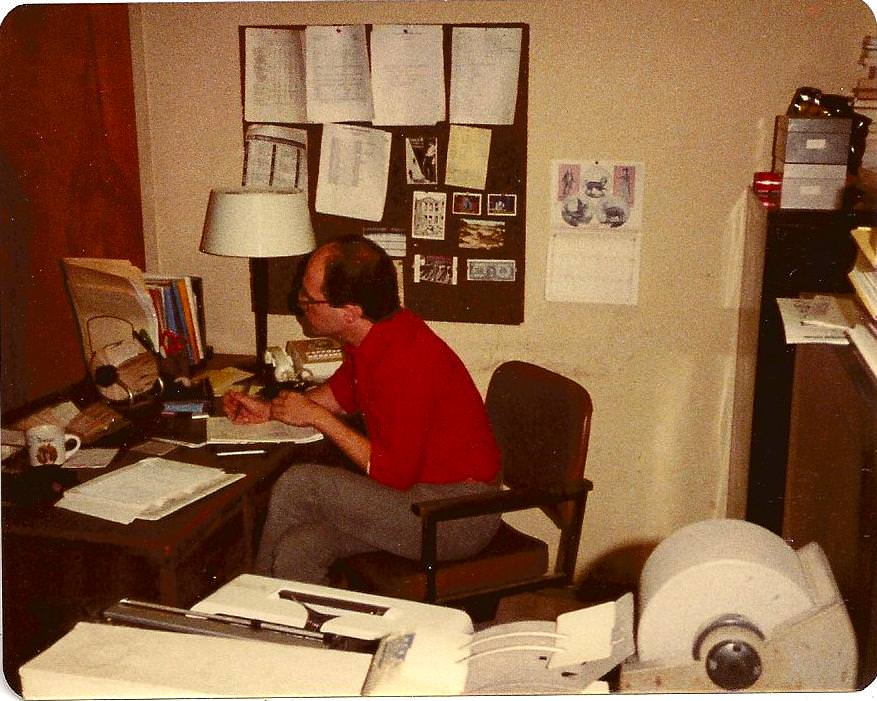This is one in a series of reminiscences by staff members of The New York Review of Books about their time working at the magazine.
The first picture shows the mailroom of The New York Review’s offices in the Fisk Building, 250 West 57th Street, where I toiled from the spring of 1980 until the spring of 1981, when I was translated upward into the realm of editorial assistance. Actually “toiled” is a bit too strong a word. The job was not exactly strenuous. My colleague Noah Shapiro and I had an arrangement whereby several afternoons a week he would leave early for music lessons, and I would arrive correspondingly late. Then I would take the mail bag to Radio City Station around 4 o’clock and fail to return. No one ever gave me grief about this, since the work, such as it was, got done, and at least in those days the Review was about as far from enforcing corporate discipline as any enterprise on earth.
Noah and I received and distributed the mail, opened packages, functioned as the reception desk and the telephone switchboard, packaged and metered outgoing mail, looked up dates and suchlike in the bound journals (you can see two frayed volumes at the bottom of the frame), fulfilled orders for back issues, fetched stats from the David Levine files (located through that nebulous hatchway at right, along with shelves of stacked issues going back to the very beginning of the Review’s existence), ran errands when the official messengers were unavailable or overburdened, engaged in the odd bit of hauling and heaving.
We also played loud music (Public Image Limited and, oddly, Hank Williams drew the most complaints from the assistant editors across the corridor), mailed unwanted or discarded books to our friends, engaged in rogue interior decoration. Two of my contributions are prominent in the picture: the poster for Christy Rupp’s “Animals Living in Cities” show at ABC No Rio and my friend Janet Stein’s highly apposite “Join the Unwork Force” broadside. Noah was probably responsible for the B. B. King/Bobby “Blue” Bland poster, perhaps also the twin portraits of Squeaky Fromme. Other items preceded our tenure, some so old they seemed to have simply grown on the walls, like lichen. The montage eventually covered all four walls as well as the ceiling, and leaked out the door into the main hallway. No one seemed to mind, and anyway most visitors did not so much as glance in our direction. A silhouette would glide by and a minute later commotion would erupt in Bob Silvers’s or Barbara Epstein’s offices. Sometimes there would be a frenetic ballet of persons rushing around with sheets of paper in their hands, sometimes the TV would be switched on to breaking news, sometimes there’d be uproarious laughter—often a sign that Jonathan Miller was in the house.
The second photo shows me sitting at my desk outside Barbara’s office—her door is to the left. I’d guess from the other pictures on the roll that it dates from the fall of 1982; it was taken by my friend and colleague Darryl Pinckney, who would a few years later occupy the same seat. Note how simple and reasonably tidy everything looks: a telephone, a typewriter, no more than three Rolodexes, a short stack of papers, and, just left of my right hand, my package of Gauloises tobacco, since those were still the days when smoking went on everywhere at all times. It wasn’t always so tidy, because daily life at the Review was ruled by emergency and catastrophe—toutes proportions gardées, of course, since an “emergency” could involve Reviewer X needing to receive immediately the fourth revised galleys of the book under review, a matter made slightly more complicated by the fact that she was at that moment touring Outer Mongolia by camel, and many many phone calls had to be placed to locate that night’s yurt three hundred leagues southwest of Ulan Bator in order to guide the DHL truck.
My duties included typing up Barbara’s correspondence (which I did with one finger, never having learned to touch-type), taming the contents of Barbara’s unruly desk, making restaurant reservations, making coffee, coping with unsolicited manuscripts (poetry, primarily), and cutting the final galleys into column-wide strips and taping the ends together so that each piece made up one roll ready to be pasted up. The scale of the office was intimate and I sat right in the middle of it, very self-conscious at all times but generally invisible to the great and the good who passed by. I imagined an early scene in some novel, maybe by Dreiser: the young clerk at his desk, his pen suspended in midair as he observes this or that eminence on parade. Isaiah Berlin, Lincoln Kirstein, Joan Didion, the debonair Murray Kempton, V. S. Pritchett who still sometimes turned in holograph manuscripts, Edward Gorey towering in his raccoon coat and white Keds. Not many of the names meant much to me at first; I came from another culture in another part of town.
Advertisement
From my desk I looked straight into Bob’s office, with his three assistants fanned out and thousands of books in teetering piles everywhere, like an office in an eighteenth-century engraving. The publisher, the late Whitney Ellsworth (whose business cards had a subscription form printed on the back), had his office next to Bob’s, and then two rooms respectively held advertising and everything else. Any sufficiently small office worth its salt is a situation comedy, and the Review office was no exception. In such an environment everyone’s personality is distilled down to one or two signal traits that reassure as they entertain. For example, typesetter Prudence Crowther’s careening laughter, subscription manager Mike Johnson’s ballplayer shuffle, layout artist Janet Noble’s eloquently arched eyebrows—the list could go on at some length—could be plugged into any given situational emergency or catastrophe for comic effect. My predecessor April Bernard and I in fact concocted just such a script about the office (which also featured the restless ghosts of Edmund Wilson and Vladimir Nabokov constantly butting into the action). It might have shown real sitcom promise, although I don’t think we ever bothered to write it down.
It does seem odd to think of The New York Review as a small business, but so it was, although it was one of the larger enterprises in the Fisk Building. That edifice, which is right now being converted into what will presumably be luxurious corporate suites, was then typical of office buildings on the déclassé fringes of midtown Manhattan. It was a warren of one- and two-room concerns, few of them with more than two or three employees: opera newsletters, foreign-language lecture bureaus, highly specialized travel agencies, jackleg import-export firms, small-time currency speculators, perhaps a private detective or two. The Review’s intellectual power and glamour may have been exceptional in such a setting, but its eccentricity ensured its fit. The place was a latter-day variant on A. J. Liebling’s Jollity Building—everybody had a racket going. Our racket was tough books.




